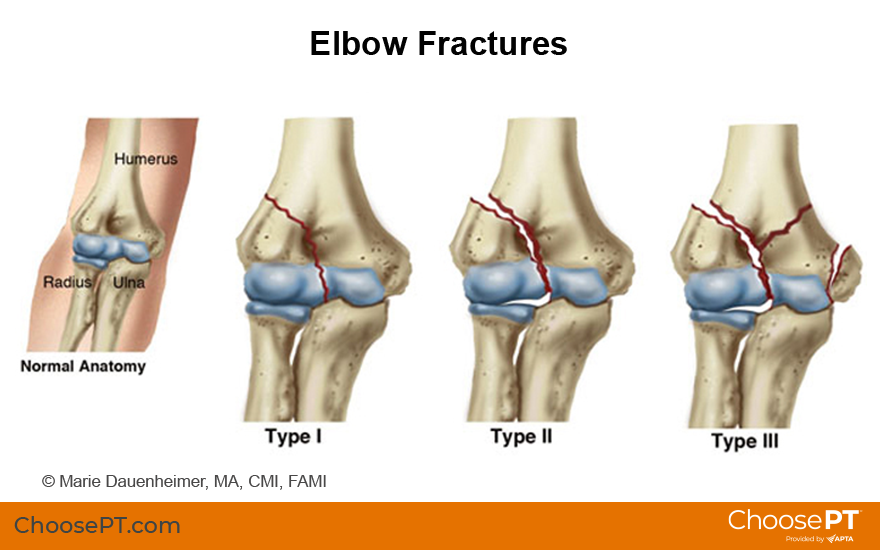Physical Therapy Guide to Elbow Fracture
An elbow fracture is a bone break that occurs in the middle of the arm, in the area of the elbow joint. Its main cause is trauma, such as falling on the elbow or falling on an outstretched hand. An elbow fracture can happen to anyone. Recent studies have identified a high number of fractures among children, women, and older adults. Children have the highest rate of elbow fractures: 30 out of every 10,000 children in the United States are affected. Elbow fractures are diagnosed in 7.4 out of every 10,000 American adults, with lower-income adults highly affected. Athletes often experience elbow fractures.
Physical therapists design personalized treatment programs to help people with elbow fractures improve elbow movement and strength, ease swelling, and restore arm use. They also help prevent problems in other arm areas (hand, wrist, shoulder) that can occur when the elbow is immobilized in a cast or splint.
Physical therapists are movement experts. They improve quality of life through hands-on care, patient education, and prescribed movement. You can contact a physical therapist directly for an evaluation. To find a physical therapist in your area, visit Find a PT.
See our guide on falls and falls prevention.
What Is an Elbow Fracture?
Elbow fractures are bone breaks that can happen in any of the three bones near the elbow joint (humerus, radius, or ulnar bones). Often, a person will feel or hear a snap or pop in the elbow area at the time of the injury. An elbow fracture can happen from falling on or being hit in the hand, wrist, elbow, or shoulder. The fracture can be a crack in the bone, a bone chip, or a more serious splitting of the bone.
There are three types of bone fractures:
- Type I. A "nondisplaced" fracture where the bone has a break but is still in its normal position.
- Type II. A fracture where a fragment of bone is shifted from its normal position.
- Type III. The most serious type of fracture, with multiple breaks in the bone.
Type I and II fractures are usually treated without surgery, while type III fractures typically need surgery. Depending on their severity and each person's general health, fractures can take two to eight weeks or more to heal.
Physical therapy can help speed recovery from all types of elbow fractures, including after surgery.

How Does It Feel?
If you have an elbow fracture, you may experience:
- Moderate to severe pain. It's usually too painful to move the arm.
- Tightness, stiffness, or cramping in the arm.
- Swelling, throbbing, redness, or numbness in the area.
- A grinding or catching sensation at the elbow.
- An unusual shape to the bones in the area (deformity).
- Tenderness to touch. The area also may feel hot.
- Numbness in the elbow, forearm, wrist, or hand. If you experience sudden numbness and weakness in your forearm or hand after an elbow fracture, it could indicate nerve compression. See a physician immediately!
How Is It Diagnosed?
If a physical therapist suspects you have an elbow fracture, they will refer you to a physician, who may order an X-ray. Your physical therapist can check for damage to other joints and muscles, and make sure that the broken bone has not affected your arm’s nerves and blood vessels.
In most cases, people with fractures visit a physician who specializes in managing bones and joints (orthopedist). Depending on the type of fracture, the physician might prescribe a cast or a sling. With severe fractures, they may prescribe surgery.
How Can a Physical Therapist Help?
After an elbow fracture, your physical therapist will tailor a treatment program to help improve your elbow movement and strength, ease swelling, and restore the use of your arm for daily living and athletic activities.
While Your Elbow Is in a Cast or Sling
While your bone heals, your arm will be in a cast or sling to keep it still and allow healing. This is also the case if you have had surgery. During the healing process, it is important to prevent as much stiffness, weakness, or swelling as possible. Depending on how much activity your physician allows for your type of fracture or surgery, your physical therapist will prescribe exercises to keep your shoulder, wrist, and hand moving while you are in the cast or sling.
Your physical therapist will help you stay as independent as possible by teaching you how to do your daily activities — such as dressing, working on a computer, housekeeping, and even exercising — while wearing a cast or a sling. Under your physical therapist's guidance, you can exercise your other arm and legs to maintain and build your fitness level during healing.
When the Cast or Sling Is Removed
After wearing a sling or cast for weeks until your bones heal, your elbow will be stiff. Your arm also may be weak, especially if you had surgery. Your physical therapist will examine your elbow and select treatments based on your physical problems, goals, level of physical activity, and health. Your physical therapist will help you prevent a permanent loss of movement in the elbow, which can sometimes occur after prolonged immobilization. The sooner you see a physical therapist, the sooner you can work toward safely getting back to peak movement.
Your physical therapist may prescribe treatments to help you:
Reduce pain and swelling. Your physical therapist may use treatments such as massage, gentle electrical stimulation, and targeted cold treatments to reduce pain and swelling.
Improve your ability to move. Your physical therapist will choose specific activities and treatments to help restore movement in your elbow and arm. They may begin with "passive" motions that your therapist performs for you to gently move your elbow joint and progress to active exercises and stretches that you do yourself.
Increase flexibility. Your physical therapist may gently apply hands-on treatment (manual therapy) to enable your joints and muscles to move more freely with less pain. These techniques can include stretches and therapeutic massage techniques.
Increase strength. If your physical therapist finds any weakness in your arm or hand muscles, your therapist will choose and teach you the correct exercises and equipment to steadily restore your strength. You might use equipment, such as therapy bands, therapy putty, and hand weights, to help strengthen your arm.
Improve endurance. Restoring your arm's muscular endurance is important after an injury. Your physical therapist will develop a program of activities to help you regain the endurance you had before the injury, so you can return to doing the things that you like to do.
Learn a home program. Your physical therapist will teach you strengthening and stretching exercises to perform at home. These exercises will be specific for your needs; if you do them as prescribed by your physical therapist, you can speed up your recovery.
Return to activities. Your physical therapist will discuss your activity goals with you and use them to set your work, sport, and home-life recovery goals. Your treatment program will help you reach your goals in the safest, fastest, and most effective way possible. Your physical therapist will teach you exercises, work-retraining activities, and sport-specific techniques and drills to help you achieve your goals.
Speed recovery time. Your physical therapist is trained and experienced in choosing the best treatments and exercises to help you safely heal, return to your normal lifestyle, and reach your goals faster than you are likely to do on your own.
Can This Injury or Condition Be Prevented?
Your physical therapist can recommend a few ways to prevent elbow fractures, including:
- Avoiding hard hits to the elbow, shoulder, or hand.
- Avoiding falls or other trauma to the arm. Your physical therapist is an expert at determining your risk of falling and can teach you how to perform balance exercises to lower that risk. Your therapist also can teach you how to decrease the risk of falling in your home and community by:
- Clearing floors of loose items and throw rugs.
- Lighting dark hallways.
- Keeping pets away from your feet when walking.
- Practicing simple balance techniques.
- Avoiding walking in icy areas.
- Wearing nonslip shoes/boots during wintry weather conditions.
- Walking carefully near "wet floor" signs.
- Using protective equipment during sports, such as wrist guards or elbow pads.
- Learning safer falling positions and techniques for sports.
- Always warming up before starting a sport or heavy physical activity.
- Gradually increasing the amount or intensity of any athletic activity.
What Kind of Physical Therapist Do I Need?
All physical therapists are prepared through education and experience to treat a variety of conditions or injuries. You may want to consider:
- A physical therapist who is experienced in treating people with orthopedic problems. Some physical therapists have a practice with an orthopedic focus, and some even specialize in arm and hand injuries.
- A physical therapist who is a board-certified clinical specialist or who completed a residency or fellowship in orthopedics, sports physical therapy, or hand therapy. This therapist has advanced knowledge, experience, and skills that may apply to your condition.
You can find physical therapists who have these and other credentials by using Find a PT, the online tool built by the American Physical Therapy Association to help you search for physical therapists with specific clinical expertise in your geographic area.
General tips when you're looking for a physical therapist (or any other health care provider):
- Get recommendations from family, friends, or other health care providers.
- When you contact a physical therapy clinic for an appointment, ask about the physical therapists' experience in helping people with elbow fracture.
- Be prepared to describe your symptoms in as much detail as possible and say what makes your symptoms worse.
The American Physical Therapy Association believes that consumers should have access to information to:
- Inform their health care decisions.
- Prepare them for their visit with a health care provider.
The following resources offer some of the best scientific evidence related to physical therapy treatment of the elbow or after an elbow fracture. They report recent research and provide information on the standards of practice in the United States and worldwide. They link to a PubMed* abstract (which may offer free access to the full text) or to other helpful resources. You can read them to learn more or bring a copy to your health care provider.
Patel DS, Statuta SM, Ahmed N. Common fractures of the radius and ulna. Am Fam Physician. 2021;103(6):345–354. Article Summary in PubMed.
Carlock KD, Bianco IR, Kugelman DN, et al. Risk factors for elbow joint contracture after surgical repair of traumatic elbow fracture. J Am Acad Orthop Surg. 2021;29(4):e178–e187. Article Summary in PubMed.
*PubMed is a free online resource developed by the National Center for Biotechnology Information. PubMed contains millions of citations to biomedical literature, including citations in the National Library of Medicine's MEDLINE database.
Expert Review:
Jun 25, 2025
Revised:
Jul 19, 2024
Content Type: Guide
Elbow Fracture
PT, DPT
Chase Kuhn
PT, DPT
